
| (one synonym : Zonilia metapyrrha Walker, 1856) MACROGLOSSINAE, SPHINGIDAE, BOMBYCOIDEA | (donherbisonevans@yahoo.com) and Stella Crossley |
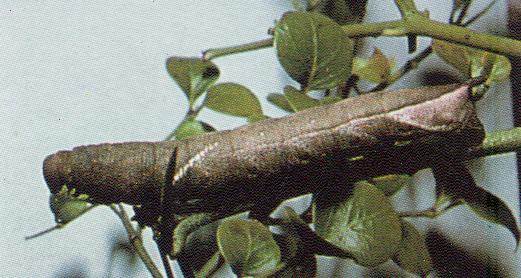
late instar
(Photo: courtesy of
Ian Common, from
Moths of Australia)

| (one synonym : Zonilia metapyrrha Walker, 1856) MACROGLOSSINAE, SPHINGIDAE, BOMBYCOIDEA | (donherbisonevans@yahoo.com) and Stella Crossley |

late instar
(Photo: courtesy of
Ian Common, from
Moths of Australia)
The early instars of this Caterpillar are green, with a long dark tail horn that curves forwards. Later instars may be green or brown, and have a white diagonal stripe pointing up and back on each side of the first abdominal segments, and a white diagonal stripe pointing down and back each side of the last abdominal segments, joined by a white lateral line along each side. The tail horn of the last instar is shorter and curves backward.
The caterpillars have been found feeding on various plants in APOCYNACEAE, including:
The caterpillar grows to a length of about 6 cms. It pupates in a cocoon in a hole dug in the ground litter. The pupa is brown with black spiracles. It has a vertically flattened protrusion in front of the head accommodating the developing haustellum. The pupa has a length of about 5 cms.
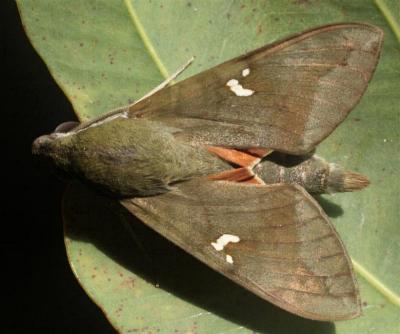
The adult moths have dark brown forewings, each with a subdued vague pattern. Some moths have white spots near the middle of each forewing, which are often associated with being male, or distinguishing subspecies. The hindwings may be either brown or red. The moths have a wingspan of about 7 cms.
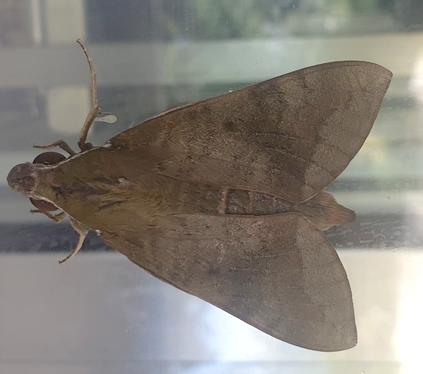
The wing coupling mechanism of the male moth, that holds the hindwing to the forewing during flight, is a hook-like tubercle called the 'retinaculum' near the hind margin of each forewing, and a bristle at the base of the hindwing called the 'frenulum'. Females have a similar device but the single bristle is replaced by a cluster of very fine bristles and the retinaculum is not as obvious. This difference is a good way of determining the sex of adult hawk moths.
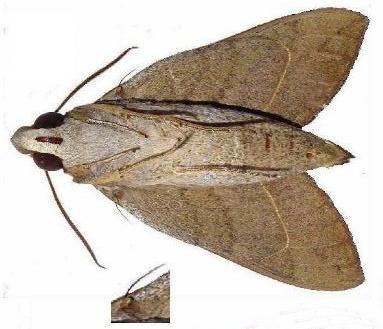
The eggs are pale green, and oval with a length of about 1.8 mms. They are laid singly on a foodplant.
The species has been found in :
as well as in Australia in
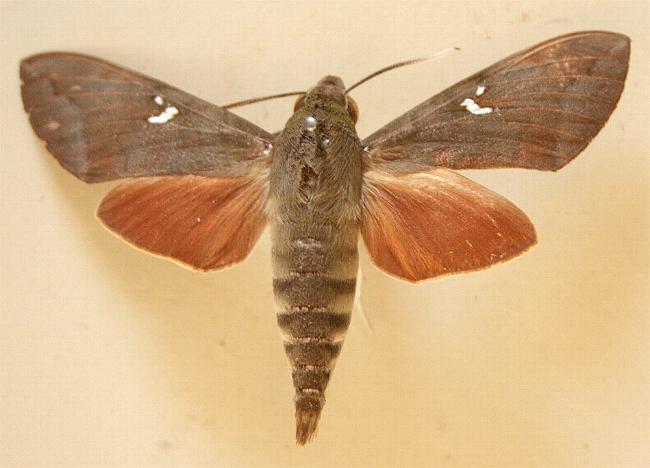
Further reading :
Ian F.B. Common,
Moths of Australia,
Melbourne University Press, 1990, fig. 41.7, pl. 29.6, p. 413.
Peter Hendry,
Lepidoptera legacy of the summer that was 2010/11,
Butterflies and Other Invertebrates Club,
Metamorphosis Australia,
Issue 61 (June 2011), pp. 18-20.
Maxwell S. Moulds, James P. Tuttle and David A. Lane.
Hawkmoths of Australia,
Monographs on Australian Lepidoptera Series, Volume 13 (2020),
pp. 208-211, Plates 52, 78, 90.
Buck Richardson,
Tropical Queensland Wildlife from Dusk to Dawn Science and Art,
LeapFrogOz, Kuranda, 2015, p. 203.
Francis Walker,
Catalogue of Lepidoptera Heterocera. Sphingidae,
List of the Specimens of Lepidopterous Insects in the Collection of the British Museum,
Part 8 (1856), p. 196, No. 9.
 caterpillar |  butterflies |  Lepidoptera |  moths |  caterpillar |
(updated 22 April 2013, 15 July 2024)